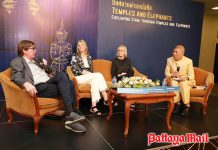Another book from the Singaporean publishers Monsoon Books, with In Grandmother’s House, subtitled “Thai Folklore, Traditions and Rural Village Life” (ISBN 978-981-08-6658-7, Monsoon Books, 2011).
It is co-authored by two very interesting writers. The principal author is Sorasing Kaowai, only son of rice farmers in a remote Thai village, whilst the secondary author is named as Peter Robinson. However, he is better known by his former ordained name of Phra Peter Pannapadipo, and author of Phra Farang and three other titles, and is a native English speaker.

The book relates to the times author Sorasing spent with his grandmother, Granny Say Karariangdee, the adult who raised him. As still happens, many children in rural Thailand are raised by their grandmothers, as the parents both have to work in the rice fields. This is the face of poverty in Thailand.
Sorasing Kaowai admits that although his spoken English is passable, his written English is not. In the preface he writes, “Peter tidied up my notes (which actually required considerably more than simple tidying up) and put my memories, research and words into a readable form. The writing style is Peter’s, the memories are mine.”
The remote village was without electricity during Sorasing’s early years with his grandmother (1980-1991), so it was a very insular life that the villagers led. In fact it was so insular that Granny Say, who was the village matriarch, was illiterate, as were the rest of the villagers. Contact with the outside world was very limited, and since nobody could write, there are no records of that period. However, in lieu of written records there were Granny Say’s memories and descriptions, which have now been recorded, albeit posthumously, as she died in 1991.
The chapters cover such diverse subjects as Thai traditional herbal medicine (Granny was the village herbalist), how to deal with snakes, spiders and creepy-crawlies, ghosts and scary monsters, the position of rice and the rice mother Mae Phosop and village celebrations.
Although the book is mainly the story of Granny Say, it is also a tribute to the fortitude of Sorasing Kaowai himself, whose mother instilled into him the need for education, believing that was the only way her son could extricate himself from farming poverty. After Granny Say died, followed two years later by his mother, the 13-year-old Sorasing ordained as a novice monk at the village temple, but then transferred to a big city monastery to start his high school studies at the free monastic school there.
The last chapter covers some additional explanatory notes and then some more folk tales not related to Granny Say’s experiences, which of course were limited to her own village and environment. These include the Mlabri tribe, the Nak Fireballs in Nong Khai, the Yasothon Rocket Festival and others throughout Thailand.
I found this a most interesting book (B. 480) and it certainly gives the reader a greater insight into just what makes up Thailand and the Thai culture. Granny Say’s era has gone, replaced by a more modern, and better educated society, but it may not actually be a “better” society.




